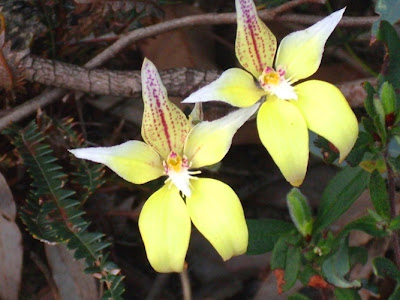Only kidding.
I'm currently revelling in being back in Africa where the mammals gallivant in the sunshine, flaunting their garish stripes and spots and ornamental tufts.
In Australia, it's all soft-pawed, nocturnal creeping; silent and cryptic and drab of fur (alright, roof-dwelling possums don't seem silent and cryptic at 3am, but you get the idea). Still I guess I'd be cryptic too, in light of Australia's extinction record. The continent has lost 27 mammal species in the last 200 years, and the trend continues...
Despite this horrifying statistic, I very much enjoyed my sojourn in Oz.
I'd like to tell you about all the exciting things I learned at the conference, but I can't. Scientific journals won't accept material that's already published, and posting stuff on a website counts as publication. So unless I want to be lynched, I can't write about anyone's research results. A bit frustrating.
 However, I can write about the day trip. When the conference delegates began swooning from information-overload, the organisers packed us up and bussed us out to Paruna Wildlife Sanctuary, a woodland reserve east of Perth. It's owned by the Australian Wildlife Conservancy who assiduously lay out poisoned baits for those arch villains, the red fox and feral cat, and then reintroduce the region's small (sorry, medium in Australia) endangered mammals (e.g. black-flanked rock wallaby, southern brown bandicoot, brush-tailed bettong and tammar wallaby).
However, I can write about the day trip. When the conference delegates began swooning from information-overload, the organisers packed us up and bussed us out to Paruna Wildlife Sanctuary, a woodland reserve east of Perth. It's owned by the Australian Wildlife Conservancy who assiduously lay out poisoned baits for those arch villains, the red fox and feral cat, and then reintroduce the region's small (sorry, medium in Australia) endangered mammals (e.g. black-flanked rock wallaby, southern brown bandicoot, brush-tailed bettong and tammar wallaby).Of course, the stomping feet of 200 behavioural ecologists would put the wind up any self respecting animal (including your average hermit) so we didn't actually see any of the aforesaid rarities. Nevertheless, we had a jolly time pottering about peering at whatever oddities interested us. You could see the ant specialists lying on their stomachs beside obscure-looking holes, the spider aficionados craning their necks beneath wisps of web, and the ever-present birders hotly debating the identity of something small, brown and very far away.
I breathed the eucalyptus-scented air, tried not to look for hippos in the dam and snapped poor-quality photos of the many wildflowers (which I'll now inflict on you). The Paruna Wildlife Sanctuary forms a 2000 ha corridor linking two national parks.
This little sundew digests ensnared bugs to get the nutrients which are unprocurable from the ancient leached soils.
Like all kangaroos, the western grey (Macropus fuliginosus) is a master at milk manufacturing. Because the needs of a growing joey change with age, mother roos fine tune the chemical composition of their milk to fit the bill. But what's really amazing is that roo mums produce two different kinds of milk at one time. One teat secretes milk suitable for the big joey hopping at foot, while the other caters for the smaller youngster who's still fixed within the pouch.
The Australian ringnecked parrot (Barnardius zonarius) is the most common parrot species in Perth. I have to admit that, living in Africa, I miss the ubiquitous presence of parrots: the colourful squabbling, the brilliant flashes as they clamber and dangle in the foliage, the fluting whistles of lorikeets and the wide-horizon shrieks of cockatoos.
























Fascinating flowers, and I love the parrot. I've never heard of that species before. Australia is definitely high on my list of dream destinations.
ReplyDeleteAwesome pics. Thanks for sharing.
ReplyDeleteJohn,
ReplyDeleteI'd never been to Western Australia before - well worth a visit!
Joe,
There were so many species flowering it was a bit overwhelming.